Art, Culture & Heritage of India :
Dance of India :
Dance in India comprises numerous styles of dances, generally classified as classical or folk. As with other aspects of Indian culture, different forms of dances originated in different parts of India, developed according to the local traditions and also imbibed elements from other parts of the country.
Sangeet Natak Akademi, the national academy for performing arts in India, recognizes eight traditional dances as Indian classical dances, while other sources and scholars recognize more. These have roots in the Sanskrit text Natya Shastra, and the religious performance arts of Hinduism.
01. BharatNatyam :

Dating back to 1000 BC, barathanatyam is a classical dance from the South Indian state of Tamil Nadu, practiced predominantly in modern times by women. The dance is usually accompanied by classical Carnatic music.barathanatyam
Bharatanatyam and other classical dances in India were ridiculed and suppressed during the colonial British Raj era. In the post-colonial period, it has grown to become the most popular classical Indian dance style in India and abroad, and is considered to be synonymous with Indian dance by many foreigners unaware of the diversity of dances and performance arts in Indian culture
02. Kathakali :
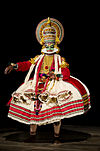
Kathakali (katha, “story”; kali, “performance”) is a highly stylized classical dance-drama form which originated from Kerala in the 17th century. This classical dance form is another “story play” genre of art, but one distinguished by its elaborately colorful make-up, costumes and face masks wearing actor-dancers, who have traditionally been all males.
Kathakali primarily developed as a Hindu performance art, performing plays and mythical legends related to Hinduism. While its origin are more recent, its roots are in temple and folk arts such as Kutiyattam and religious drama traceable to at least the 1st millennium CE. A Kathakali performance incorporates movements from the ancient martial arts and athletic traditions of south India. While linked to the temple dancing traditions such as Krishnanattam, Kutiyattam and others, Kathakali is different from these because unlike the older arts where the dancer-actor also had to be the vocal artist, Kathakali separated these roles allowing the dancer-actor to excel in and focus on choreography while the vocal artists focused on delivering their lines.
03. Kathak :
Kathak is traditionally attributed to the traveling bards of ancient northern India, known as Kathakars or storytellers. The term Kathak is derived from the Vedic Sanskrit word Katha meaning “story”, and kathaka in Sanskrit means “he who tells a story”, or “to do with stories”. Kathak evolved during the Bhakti movement, particularly by incorporating childhood and amorous stories of Hindu god Krishna, as well as independently in the courts of north Indian kingdoms. It transitioned, adapted and integrated the tastes and Persian arts influence in the Mughal courts of the 16th and 17th century, was ridiculed and declined in the colonial British era, then was reborn as India gained independence.
Kathak is found in three distinct forms, named after the cities where the Kathak dance tradition evolved – Jaipur, Benares and Lucknow. Stylistically, the Kathak dance form emphasizes rhythmic foot movements, adorned with small bells (Ghungroo), the movement harmonized to the music, the legs and torso are generally straight, and the story is told through a developed vocabulary based on the gestures of arms and upper body movement, facial expressions, stage movements, bends and turns.
04. Kuchipudi :
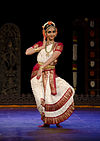
Kuchipudi classical dance originated in a village of Krishna district in modern era Indian state of Andhra Pradesh. It has roots in antiquity and developed as a religious art linked to traveling bards, temples and spiritual beliefs, like all major classical dances of India. In its history, the Kuchipudi dancers were all males, typically Brahmins, who would play the roles of men and women in the story after dressing appropriately.
Modern Kuchipudi tradition believes that Tirtha Narayana Yati and his disciple an orphan named Siddhendra Yogi founded and systematized the art in the 17th century. Kuchipudi largely developed as a Hindu god Krishna-oriented Vaishnavism tradition, and it is most closely related to Bhagavata Melaperformance art found in Tamil Nadu, which itself has originated from Andhra Pradesh . The Kuchipudi performance includes pure dance (nritta), and expressive part of the performance (nritya), where rhythmic gestures as a sign language mime the play. Vocalists and musicians accompany the artist, and the tala and raga set to (Carnatic music). In modern productions, Kuchipudi dancers include men and women.
05. Odissi :
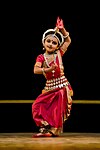
Odissi originated in the Hindu temples of Odisha – an eastern coastal state of India. Odissi, in its history, was performed predominantly by women, and expressed religious stories and spiritual ideas, particularly of Vaishnavism (Vishnu as Jagannath), but also of other traditions such as those related to Hindu gods Shiva and Surya, as well as Hindu goddesses (Shaktism). Odissi is traditionally a dance-drama genre of performance art, where the artist(s) and musicians play out a mythical story, a spiritual message or devotional poem from the Hindu texts, using symbolic costumes, body movement, abhinaya(expressions) and mudras (gestures and sign language) set out in ancient Sanskrit literature
06. Sattriya :

Sattriya is a classical dance-drama performance art with origins in the Krishna-centered Vaishnavism monasteries of Assam, and attributed to the 15th century Bhakti movement scholar and saint named Srimanta Sankardev. One-act plays of Sattriya are called Ankiya Nat, which combine the aesthetic and the religious through a ballad, dance and drama. The plays are usually performed in the dance community halls (namghar) of monastery temples (sattras). The themes played relate to Krishna and Radha, sometimes other Vishnu avatars such as Rama and Sita
07. Manipuri :

Manipuri, also known as Jagoi, is named after the region of its origin – Manipur, a state in northeastern India bordering with Myanmar (Burma). It is particularly known for its Hindu Vaishnavism themes, and performances of love-inspired dance drama of Radha-Krishna called Raslila. However, the dance is also performed to themes related to Shaivism, Shaktism and regional deities such as Umang Lai during Lai Haraoba. The Manipuri dance is a team performance, with its own unique costumes notably the Kumil (a barrel shaped, elegantly decorated skirt), aesthetics, conventions and repertoire. The Manipuri dance drama is, for most part, marked by a performance that is graceful, fluid, sinuous with greater emphasis on hand and upper body gestures
08. Mohiniyattam :
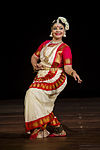
Mohiniyattam developed in the state of Kerala, gets its name from Mohini – the seductress avatar of Vishnu, who in Hindu mythology uses her charms to help the good prevail in a battle between good and evil. Mohiniyattam follows the Lasya style described in Natya Shastra, that is a dance which is delicate, with soft movements and feminine. It is traditionally a solo dance performed by women after extensive training. The repertoire of Mohiniyattam includes pure and expressive dance-drama performance, timed to sopana (slower melody) styled music, with recitation. The songs are typically in Malayalam-Sanskrit hybrid called Manipravala.
Music of India :
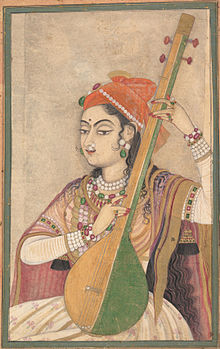
The music of India includes multiple varieties of Indian classical music, folk music, filmi and Indian pop. India’s classical musictradition, including Hindustani music and Carnatic, has a history spanning millennia and developed over several eras. Music in India began as an integral part of socio-religious life.
01. Classical music :
The two main traditions of Indian classical music are Carnatic music, which is found predominantly in the peninsular regions, and Hindustani music, which is found in the northern, eastern and central regions. The basic concepts of this music includes shruti(microtones), swaras (notes), alankar (ornamentations), raga (melodies improvised from basic grammars), and tala (rhythmic patterns used in percussion). Its tonal system divides the octave into 22 segments called shrutis, not all equal but each roughly equal to a quarter of a whole tone of the Western music.
02. Hindustani music :
The Hindustani music tradition diverged from Carnatic music around the 13th-14th centuries CE. The practice Vedic times where the hymns in Sama Veda, an ancient religious text, were sung as Samagana and not chanted. Developing a strong and diverse tradition over several centuries, it has contemporary traditions established primarily in India but also in Pakistan and Bangladesh. In contrast to Carnatic music, the other main Indian classical music tradition originating from the South, Hindustani music was not only influenced by ancient Hindu musical traditions, historical Vedic philosophy and native Indian sounds but also enriched by the Persianperformance practices of the Mughals. Classical genres are dhrupad, dhamar, khyal, tarana and sadra, and there are also several semi-classical forms.
03. Carnatic music :
The present of Carnatic music can be traced to the 14th – 15th centuries AD and thereafter. It originated in South India during the rule of Vijayanagar Empire. Like Hindustani music, it is melodic, with improvised variations, but tends to have more fixed compositions. It consists of a composition with improvised embellishments added to the piece in the forms of Raga Alapana, Kalpanaswaram, Neravaland, in the case of more advanced students, Raga, Tala, Pallavi. The main emphasis is on the vocals as most compositions are written to be sung, and even when played on instruments, they are meant to be performed in a singing style (known as gāyaki). There are about 7.2 million ragas (or scales) in Carnatic Music,[citation needed] with around 300 still in use today. Annamayya is the first known composer in Carnatic music. He is widely regarded as the Andhra Pada kavitā Pitāmaha (Godfather of Telugu song-writing). Purandara Dasa is considered the father of Carnatic music, while the later musicians Tyagaraja, Shyama Shastry and Muthuswami Dikshitar are considered the trinity of Carnatic music.[citation needed]
Noted artists of Carnatic music include Ariyakudi Ramanuja Iyengar (the father of the current concert format), Semmangudi Srinivasa Iyer, Palaghat K.V. Narayanaswamy, Alathur Brothers, MS Subbulakshmi, Lalgudi Jayaraman and more recently Balamuralikrishna, TN Seshagopalan, K J Yesudas, N. Ramani, Umayalpuram K. Sivaraman, Sanjay Subrahmanyan, Manipallavam K.Sarangan, Balaji Shankar, TM Krishna, Bombay Jayashri, T S Nandakumar, Aruna Sairam Mysore Manjunath.
Every December, the city of Chennai in India has its eight-week-long Music Season, which is the world’s largest cultural event.
Carnatic music has served as the foundation for most music in South India, including folk music, festival music and has also extended its influence to film music in the past 100–150 years or so.
Famous Musicians :
1. Mian Tansen (1506 – 1589)
One of the nine jewels (navaratnas) at Mughal emperor Akbar’s court — Mian Tansen is considered to be a pioneer of Indian classical music. His ragas are an important part of Indian culture and many of them contain the prefix, “mian ki”. For example, “Mian ki Todi” or “Mian ki Malhar”. Here is Pt. Shivkumar Sharma’s rendition of the raga, “Mian ki Malhar”.
2. Rabindranath Tagore (1861 – 1941)
Amongst several other things, Tagore was also a celebrated musician. He has to his credit 2,230 compositions. He created his songs from scratch — the tune, the lyrics, et al. Rabindrasangeet is almost a genre on its own and the diversity in his music is beyond remarkable
3. M. S. Subbulakshmi (1916 – 2004)
Subbulakshmi was a legend. She was only 13 when she gave her first performance at the Madras Music Academy and stunned the audience present. She would go on to create ripples across seven seas. She was the first musician to be awarded the prestigious Bharat Ratna, India’s highest civilian honour.
4. Pt. Ravi Shankar (1920 – 2012)
His music cannot be penned down, for its impact has been so vast that it encompasses audiences across the world. Amongst his ardent admirers and students were The Byrds and George Harrison of The Beatles. If one were to begin naming the awards he won during his lifetime, one would not stop. From the Bharat Ratna to the Honorary Knight Commander of the Order of the British Empire to three Grammy awards. He saw it all, he won it all.
5. S. Balachander (1927 – 1990)
This Padma Bhushan awardee was no less than a magician and his wand was his veena. He is credited with contemporarising the veena and boldly changing the grammar of instrumental music. His are indeed the strings of enigma. Prepare to be enthralled.
6. Pt. Shivkumar Sharma (1938 – )
A wonderful santoor player. Shivkumar Sharma is a one-of-his-kind musician. There is so much depth, so much playfulness, so much beauty in his music. He has been the recipient of Padma Shree and Padma Vibhushan and has won accolades around the world.
7. Lata Mangeshkar (1929 – )
She has been revered in the Indian music industry for over seven decades. Very few singers have such range and sweetness in their voices. After Subbulakshmi, she is the second vocalist ever to have been awarded the Bharat Ratna.
8. Mohammad Rafi (1924 – 1980)
Let’s face it. Bollywood would not have been the same without him….his music understood what Bollywood was about! It did what no one else has been able to do with as much flawlessness – it brought out the ada and captured the nuances of Bollywood moments.
9. Begum Akhtar (1914 – 1974)
A Padma Shree and a Padma Bhushan (posthumous) awardee, Akhtar was titled Mallika-e-Ghazal, so beautiful were her ghazals. Her music is achingly soulful and expresses a deep yearning.
10. Hariprasad Chaurasiya (1938 – )
An Indian classical flutist of utter brilliance, Chaurasiya, a Padma Shree and a Padma Vibushan recipient, creates wonders when he plays the flute. He has been bewitching audiences the world over with the new emotional ambience he’s brought to classical music.
11. Ilayaraja (1943 – )
Ilayaraja is one of finest composers India has today. Although most of his work is in South Indian languages, his influence is spread all over India. The range of music he has composed is mind-boggling.
12. Zakir Hussain (1951 – )
Padma Bhushan and Padma Shree recipient, Hussain is the youngest percussionist to have been awarded such high honours. This tabla maestro is capable of putting a beat to every millisecond of passing moment. Listening to him is pure bliss.
13. Bismillah Khan (1913 – 2006)
The spectacular shehnai player, Bismillah Khan, was a musician who managed to grasp the essence of Indian culture through his music. He was a Bharat Ratna as well as a Padma Vibhushan recipient.
14. A. R. Rahman (1987 – )
This man is a living legend. His music has the potential to reach corners of your emotions you did not know existed. From National recognition with a Padma Bhushan and four National Awards in his pocket, he is internationally recognised also, having won two Grammys.
15. Master Madan (1927 – 1947)
He died young at the age of 15, leaving behind just eight songs of exquisite beauty. He was a child prodigy, a ghazal singer par excellence.
16. Bhimsen Joshi (1922 – 2011)
This Bharat Ratna recipient was a Hindustani classical vocalist and a breathtaking one at that. Every nuance in his songs was profoundly clear and poignant.
17. Ustad Amjad Ali Khan (1945-)
This phenomenal sarod player is considered to be one of the greatest sarod players of the twentieth century. His music is as renowned internationally as it is on a national level and he considers his audience to be his motivation. He refuses to discriminate between genres and chooses to play “just music”.
18. R. D. Burman (1939 – 1994)
He was the man who brought in western tunes to the Hindi film industry and experimented with several other genres. He thought outside the box and broke the Bollywood music scene, marking his own niche. He is still a major influence on budding as well as established artistes of the industry.
19. Kadri Gopalnath (1949 – )
Kadri Gopalnath is a Padma Bhushan winning saxophone player and a pioneer of Carnatic music on the instrument. The kind of music he plays has a melodic richness and the amount of effort he puts in is beyond phenomenal.
20. Dr. L. Subramaniam (1947 – )
This violinist makes music of sheer class. A violinist of spectacular stature, Subramaniam has numerous awards to his name, including the Padma Bhushan.
Famous Instrumentalists :
Indian classical musicians and singers have played a great role in popularizing Indian music all across the world. They have enriched the world of music and enthralled the audiences with their masterful artistry. Their soulful rendition has brought solace to many a hearts. Here is a brief profile of Famous Indian classical musicians.
01. Ustad Ali Akbar Khan
Ustad Ali Akbar Khan was one of the most accomplished Indian classical musicians, admired all over the world for his brilliant compositions and his mastery of the sarode. Read more at http://www.iloveindia.com/indian-heroes/musicians.
02. Ustad Amjad Ali Khan
Ustad Amjad Ali Khan was born at Gwalior Madhya Pradesh in 1945. He belongs to the illustrious Bangash lineage rooted in the Senia Bangash School of music and is the sixth generation sarod player in his family.
03. Hariprasad Chaurasia
Pandit Hariprasad Chaurasia, is a world-renowned exponent of the bansuri or bamboo flute. He is one of those rare classical musicians who expanded the peripheries of classical music by taking it to the common masses.
04. MS Subbulakshmi
MS Subbulakshmi was a legendary Carnatic musician. She was popularly known as Nightingale of India. Her rendering of bhajans (devotional songs) was divine and used to enthrall and transfix listeners, and transport them into a different world.
05. Bismillah Khan
The legendary shehnai player, Ustad Bismillah Khan was one of India’s most celebrated classical musicians. Bismillah Khan has been credited with taking the shehnai from the marriage mandap to the concert hall.
06. Ravi Shankar
Ravi Shankar is a legendary sitar player and one of India’s most esteemed classical musicians. Pandit Ravi Shankar has made a major contribution in popularizing Indian classical music in the West through his association with The Beatles (especially George Harrison).
07. Shiv Kumar Sharma
Shiv Kumar Sharma’s name is synonymous with santoor, Indian classical music instrument. Pandit Shiv Kumar Sharma is credited with single-handedly making the santoor a popular classical instrument.
08. Zakir Hussain
Zakir Hussain is a classical tabla virtuoso and the most famous tabla player in India today. His contribution in the field of percussion and in the music world at large is highly appreciated.
Latest Govt Job & Exam Updates:

